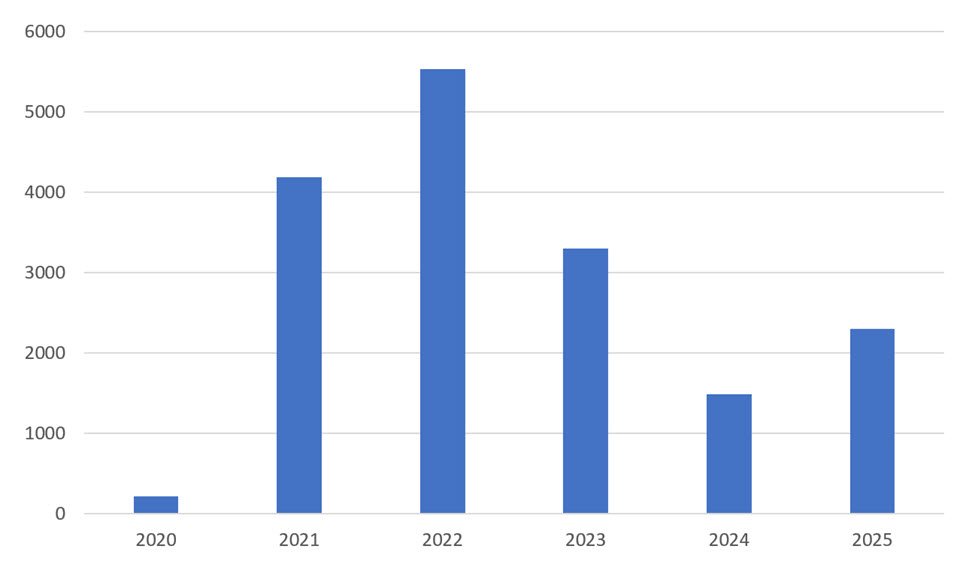Here’s what to know about the malware with an insatiable appetite for valuable data, so much so that it tops this year’s infostealer detection charts
22 Oct 2025
•
,
3 min. read

Infostealers remain one of the most persistent threats on today’s threat landscape. They’re built to quietly siphon off valuable information, typically login credentials and financial and cryptocurrency details, from compromised systems and send it to adversaries. And they do so with great success.
ESET researchers have tracked numerous campaigns recently where an infostealer was the final payload. Agent Tesla, Lumma Stealer, FormBook and HoudRAT continue to make the rounds in large numbers, but according to the ESET Threat Report H1 2025, one family surged ahead of the rest in the first half of this year: SnakeStealer.
A threat is born
Detected by ESET products mainly as MSIL/Spy.Agent.AES, SnakeStealer first appeared in 2019. Early reports traced it to a threat originally marketed as 404 Keylogger or 404 Crypter on underground forums before it rebranded under its current name.

In its early variants, SnakeStealer used Discord to host its payloads, which victims unwittingly downloaded after opening a malicious email attachment. While hosting malware on legitimate cloud platforms wasn’t new, the widespread abuse of Discord soon became a hallmark tactic. SnakeStealer reached its first big wave of activity in 2020 and 2021, spreading globally without any clear regional focus.
Meanwhile, the delivery methods varied. Phishing attachments still remain the primary vector, but the payload itself may be disguised in various forms, including password-protected ZIP files, weaponized RTF, ISO and PDF files, or even bundled with other malware. Occasionally, SnakeStealer hides inside pirated software or fake apps, which speaks to the fact that not every compromise begins with a malicious email.

Malware-as-a-service: A profitable ‘business model’
Like many other modern threats, SnakeStealer follows the malware-as-a-service (MaaS) model. Its operators rent or sell access to the malware, complete with technical support and updates, which makes it easy for even low-skilled attackers to launch their own campaigns.
SnakeStealer’s recent resurgence is no coincidence. After Agent Tesla began to decline and lose developer support, underground Telegram channels started recommending SnakeStealer as its successor. This endorsement, combined with the convenience of its MaaS setup and its ready-made infrastructure, propelled SnakeStealer to the top of detection charts, so much so that SnakeStealer was recently responsible for almost one-fifth of global infostealer detections as tracked by ESET telemetry.

Key features
SnakeStealer may not break new ground, but it’s polished, reliable, and easy to deploy. It offers a full toolkit of capabilities that’s typical of professional-grade info-stealing malware, and given its modularity, attackers can switch features on or off to suit their needs.
- Evasion: In order to stay under the radar, SnakeStealer can terminate processes associated with security and malware analysis tools and check for virtual environments.
- Persistence: It alters Windows boot configurations to maintain access on compromised systems.
- Credential theft: It extracts saved passwords from web browsers, databases, email and chat clients, including Discord, and Wi-Fi networks.
- Surveillance: It captures clipboard data, takes screenshots and logs keystrokes.
- Exfiltration: It sends stolen data via FTP, HTTP, email, or Telegram bots.
How to protect yourself
Whether you’re an individual user or a business, these steps can help reduce the risk against infostealers like SnakeStealer:
- Be skeptical of unsolicited messages. Treat attachments and links, especially from unknown senders, as potential threats, even if they appear legitimate. Verify them with the sender through other channels.
- Keep your system and apps updated. Patching known vulnerabilities in a timely manner reduces the risk of compromise stemming from software loopholes.
- Enable multi-factor authentication (MFA) wherever possible. Even if your password is stolen, MFA can stop unauthorized logins.
- If you suspect a compromise: change all passwords from a clean device, revoke open sessions, and monitor your accounts for suspicious activity.
- Use reputable security software on all devices, desktop and mobile alike.
Final thoughts
SnakeStealer’s rise is a reminder of how quickly the cybercrime market adapts and as such reflects a larger truth about today’s threat landscape: cybercrime has industrialized. This professionalization makes it easier than ever for anyone to steal data at scale. And as one infostealer fades, another fills the gap, armed with largely the same tried-and-tested tactics. The good news is that strong cybersecurity practices will go a long way towards keeping you safe.



